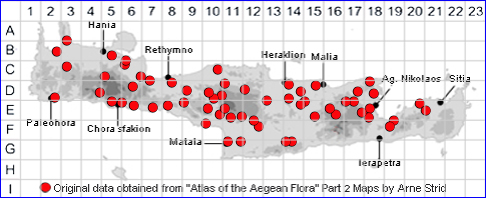
CYNOGLOSSUM COLUMNAE
Family and Genus:- See- BORAGINACEAE
Common Names:- None
Homotypic Synonyms:- Mattia columnae, Rindera columnae.
Meaning:- Cynoglossum (Gr) Hound's-tongue, a name used by the Greek
physician Dioscorides' to describe the rough texture of the leaf.
Columnae (L) Named after the Italian botanist Fabio Colanna.
General description:- Fairly robust short to medium, softly hairy biennial
Stems:-
1) (15-)25-45(-60) cm, angular, erect, branched above, hirsute.
Leaves:-
1) Cauline, oblong to lanceolate, semi-amplexicaul. sessile, tomentose, on both
surfaces.
Flowers:-
1) Cymes, branched flat-topped or convex ebracteate, flower clusters. which
elongate in fruit.
2) Calyx-lobes, c. 5 mm, ovate, hirsute.
3) Corolla, 5-6 mm, purplish to deep blue.
a) tube, broadly cylindrical.
4) Stamens, inserted in upper part of the tube.
Fruit:-
1) Nutlets, 7-10 mm diam, with a thickened edge giving a distinct border, beset with
glochidia on the disc, shorter than those on the margin.
Key features:-
1) Cymes, ebracteate (rarely bracteate at the base).
2) Nutlets, 7-10 mm diam.
Habitat:- Rocky slopes with dry open shrubby vegetation. Open woodland and
meadows, mainly over limestone, 0-1500 m.
Distribution:- Fairly common throughout Greece except in most of the NE. - C & E
Mediterranean region from ltaly to W Anatolia. Widespread and common on Crete.
.
Flowering time:- Feb-June.
Photos by:- Steve Lenton
SPECIES DESCRIPTION
